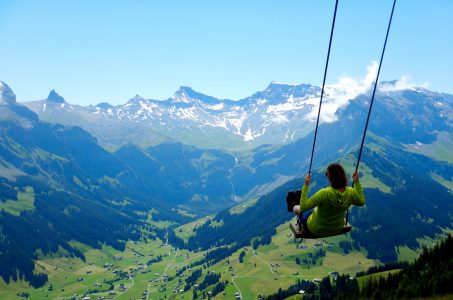Switzerland, like many countries, has suffered losses in tourism. However, in an effort to maintain the safety of visitors and their hosts, the country has devised new sustainability programmes.
Although it is known for skiing in the Alps and the highest peaks in Europe, judging by the number of foreign tourists, summer tourism is still the most developed tourism branch in Switzerland. Namely, the country records the highest number of visitors during July. According to statistical data from 1996 to 2021, a record number of foreign tourists was recorded by Switzerland in July 2019, a total of 1,296,908.

The tendency that was noticed all over the world in the year before the epidemic was that most countries broke all records in the number of foreign arrivals, including Switzerland. Only a year later, there was a noticeable drop in tourist traffic. Thus, in April 2020, Switzerland had the least number of tourists, only 10,610. There was an increase in 2020, but it seems that the 2019 record numbers seem unattainable.
The Clean & Safe programme as a step towards sustainable tourism, especially during the pandemic
The tourism trade associations have launched the ‘Clean & Safe’ label. The label lets guests know that they are visiting an establishment that has consciously committed to complying with the safety concept. The ‘Clean & Safe’ campaign is supported by Switzerland Tourism. Service suppliers are responsible for ensuring that the safety protocols are implemented and complied with. Cantonal regulations must also be taken into account in the protection concepts and measures.
The relevant industries, companies and event organisers are developing safety concepts aimed at protecting their guests.
The relevant industries, companies and event organisers are developing safety concepts aimed at protecting their guests. These concepts are based on rules for hygiene and behaviour, as well as public health and employee protection guidelines issued by the Federal Office of Public Health (FOPH) and the State Secretariat for Economic Affairs (SECO). All event organisers and businesses must plan and implement the necessary social distancing and hygiene measures. The aim of these safety concepts is to protect customers and participants to the greatest degree possible against the coronavirus.
Safety measures in the accommodation sector
- Hand hygiene: Regular hand washing, avoid touching objects and surfaces wherever possible
- Social distancing: Employees and other persons must maintain a distance of 1.5 metres from each other, transit and waiting zones will be designated (using room dividers if necessary), regulation of the number of people occupying given spaces
- Cleaning: Appropriate, regular cleaning of surfaces and objects after use, especially if they are touched by several people.
- Poeple without a Covid certificate are allowed indoors but protective masks are compulsory.
- There is a Covid certificate requirement for indoor catering establishments (restaurants, bars, cafés, clubs, etc.). No certificate requirement in outdoor areas and for room service.
Safety measures in the catering industry
Catering establishments are generally open in strict compliance with the protection concept. In the indoor area, there is a Covid certificate obligation. In outdoor areas, there is no certificate obligation.
The protection concept for the hospitality industry under COVID-19 applies to all providers of gastronomic services and regulates the implementation of the requirements adopted by the Federal Council in everyday operations.
20 years UNESCO Biosphere Entlebuch
The horizon had darkened dramatically in the Entlebuch when on December 6, 1987, the Rothenthurm Initiative for a comprehensive protection of the moorlands was accepted. The outcome of the vote in favour of moorland protection left the people of Entlebuch, especially those employed in agriculture and tourism, somewhat perplexed.
The region threatened to degenerate into a reserve. But the people of Entlebuch set out for new horizons and, with a great deal of commitment and heart and soul, got their region moving together.
Together, they focused on genuinely sustainable action in all areas, promoted regional development and value creation with their own brand and certified regional products, made a strong case for gentle tourism with nature- and climate-compatible offers, promoted renewable energies and actively communicated to a diverse and steadily growing audience in the sense of an educational mission.
Apparently so well that the Entlebuch Biosphere was elevated to a model biosphere for the world on the occasion of the ten-yearly review by UNESCO in 2011. We are proud of this and continue to work on it. Together with our population.
Home of mountain goats
Switzerland is home to around 17,000 ibex, a figure that is all the more surprising considering how in Graubünden – the canton whose coat-of-arms bears an ibex – they became extinct during the 19th century due to hunting. The ibex was reintroduced in the National Park between 1920 and 1934.
The horns are the most striking feature of the ibex. Large and impressive on the male, smaller and more delicate on the female, this headdress almost proved fatal for the Alpine animals. As a coveted source of medicine as well as a valuable trophy, ibexes were hunted and eradicated in the Swiss Alps.
Fortunately for visitors, ibex gather in the vicinity of some cableway termini and villages, such as Pontresina.
Today, thanks to a breeding and reintroduction programme, there are again ibexes in Switzerland.
To see them in the summer, you need to go high. These mountain goats’ favourite habitat is rocky terrain far above the tree line. Fortunately for visitors, ibex gather in the vicinity of some cableway termini and villages, such as Pontresina.
As soon as the grass starts to sprout in the valley, the mighty animals in the Albris colony, a little the worse for wear after the winter, venture down towards the upper edge of the village and can be observed grazing, basking in the sun and tussling amongst themselves.